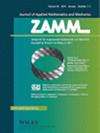ZnO + Al2O3 + TiO2/DW三元杂化纳米流体传热的分形分数分析与数值模拟
IF 3.2
4区 工程技术
Q1 MATHEMATICS, APPLIED
Zamm-zeitschrift Fur Angewandte Mathematik Und Mechanik
Pub Date : 2023-09-30
DOI:10.1002/zamm.202300459
引用次数: 1
摘要
摘要纳米流体是在常规流体中以最小的纳米颗粒浓度获得最大的热性能和稳定悬浮的流体。纳米流体在对流过程中的有效性受到其增加的热物理特性的显著影响。然而,这项技术并没有到此为止;二元和三元纳米流体现在被用于提高常规流体的效率。因此,本文旨在分析自然对流牛顿三元纳米流体在垂直通道中的流动。将氧化锌ZnO、氧化铝al2o3和氧化钛tio2的三杂化纳米粒子溶解在碱液蒸馏水(DW)中形成均匀悬浮液。假设了热辐射、焦耳加热和粘性耗散的影响。利用分形-分数阶导数算子对经典牛顿三元纳米流体模型进行了推广。采用Crank-Nicolson格式对广义模型进行离散化,并用计算软件进行求解。为了分析流体的流动行为和流体中的热分布,对得到的解进行了数值计算,并对不同物理参数下的解进行了绘图。从图中可以看出,当体积分数φ达到0.04(基液的4%)时,三元纳米流体的传热率比二元和一元纳米流体的传热率显著增强。这种传热速率的提高会改善基液的热物理特性,如粘度、热膨胀和热容量等。这里还值得一提的是,随着埃克特数、辐射参数和焦耳加热参数的取值越高,热场也越强。本文章由计算机程序翻译,如有差异,请以英文原文为准。
Fractal‐fractional analysis and numerical simulation for the heat transfer of ZnO + Al2O3 + TiO2/DW based ternary hybrid nanofluid
Abstract Nanofluids are used to achieve maximum thermal performance with the smallest concentration of nanoparticles and stable suspension in conventional fluids. The effectiveness of nanofluids in convection processes is significantly influenced by their increased thermophysical characteristics. However, this technology is not ended here; binary and ternary nanofluids are now used to improve the efficiency of regular fluids. Therefore, this paper aims to analyze the natural convection Newtonian ternary nanofluid flow in a vertical channel. The tri‐hybridized nanoparticles of zinc oxide ZnO, Aluminum oxide Al 2 O 3 , and titanium oxide TiO 2 is dissolved in base fluid distilled water (DW) to form a homogenous suspension. The impact of thermal radiation, joule heating, and viscous dissipation are also assumed. The classical Newtonian ternary nanofluid model has been generalized by using fractal‐fractional derivative (FFD) operator. The generalized model has been discretized by using the Crank–Nicolson scheme and then solved by using computational software. To analyze the behavior of fluid flow and heat distribution in fluid, the obtained solution was computed numerically and then plotted in response to different physical parameters. It is noted from the figure that when the volume fraction ϕ reaches to 0.04 (4% of the base fluid), the ternary nanofluid flow shows a significant amount of enhancement in heat transfer rate as compared to binary and unary nanofluid flows. This enhancement in the rate of heat transfer leads to improve the thermophysical characteristics such as viscosity, thermal expansion, and heat capacity etc. of the base fluid. It is also worth mentioning here that the thermal field is also enhance with the higher values of Eckert number , radiation parameter , and joule heating parameter .
求助全文
通过发布文献求助,成功后即可免费获取论文全文。
去求助
来源期刊
CiteScore
3.30
自引率
8.70%
发文量
199
审稿时长
3.0 months
期刊介绍:
ZAMM is one of the oldest journals in the field of applied mathematics and mechanics and is read by scientists all over the world. The aim and scope of ZAMM is the publication of new results and review articles and information on applied mathematics (mainly numerical mathematics and various applications of analysis, in particular numerical aspects of differential and integral equations), on the entire field of theoretical and applied mechanics (solid mechanics, fluid mechanics, thermodynamics). ZAMM is also open to essential contributions on mathematics in industrial applications.

 求助内容:
求助内容: 应助结果提醒方式:
应助结果提醒方式:


